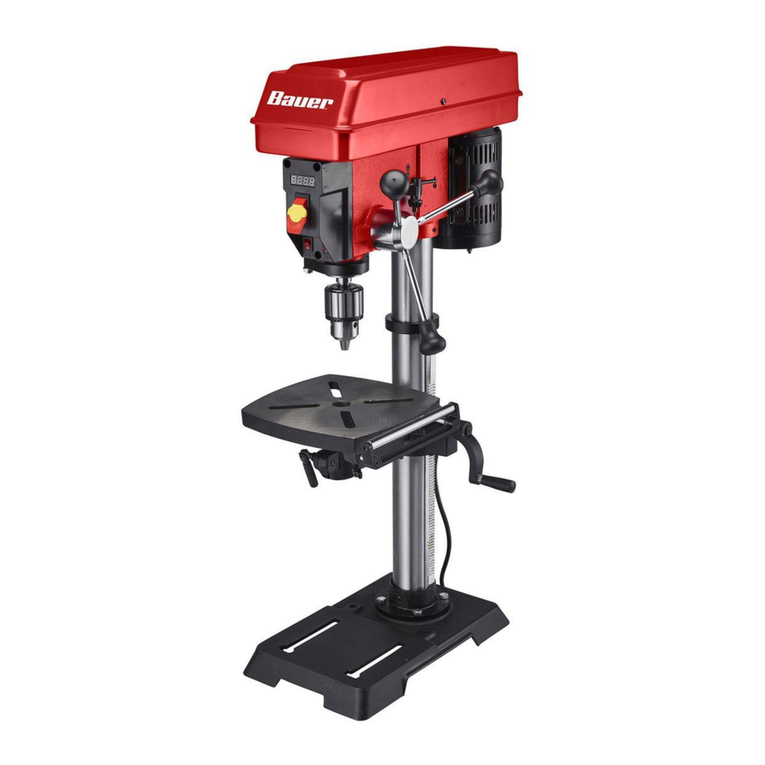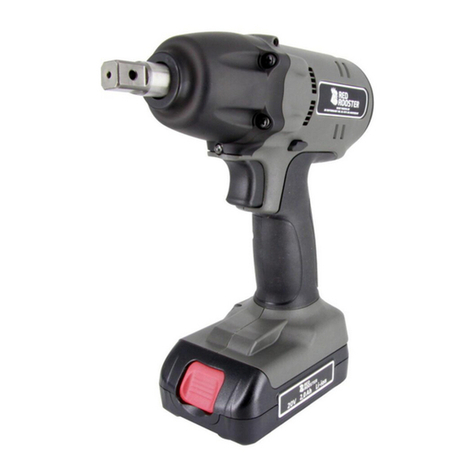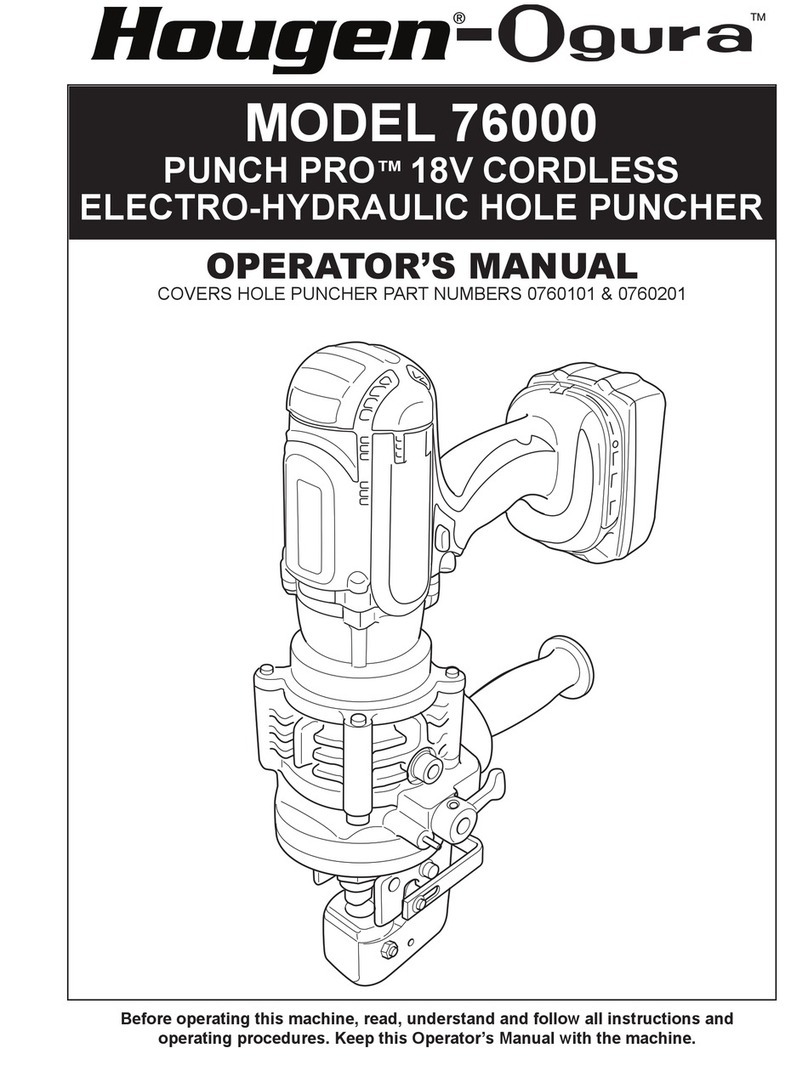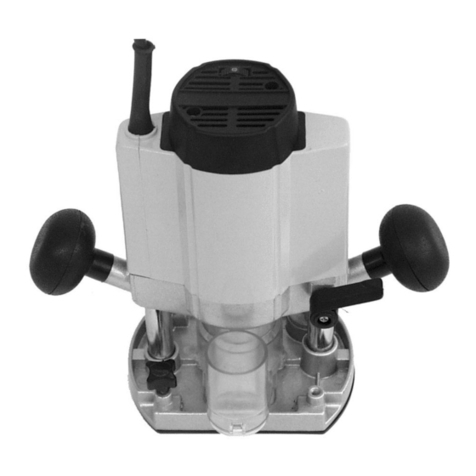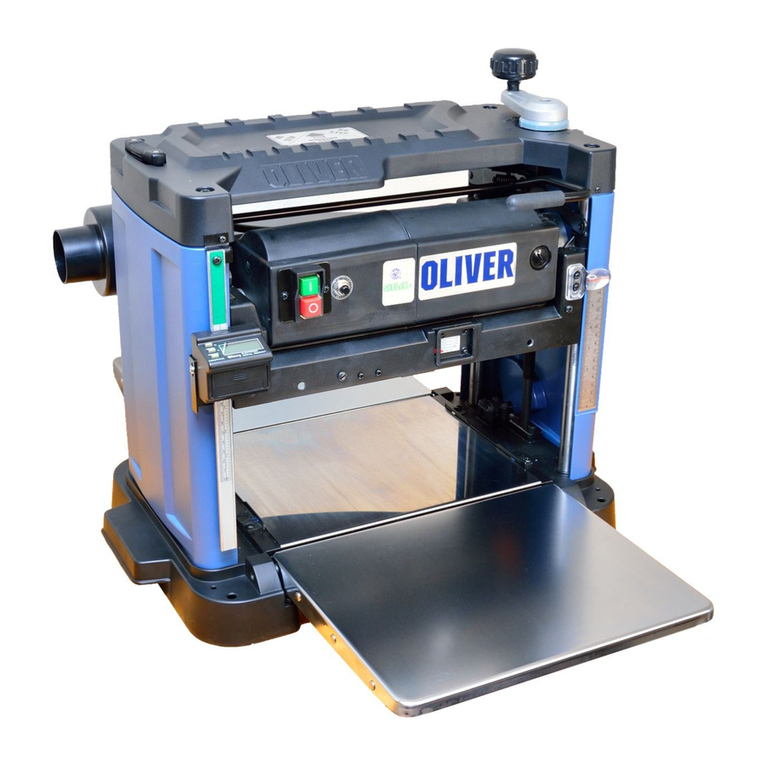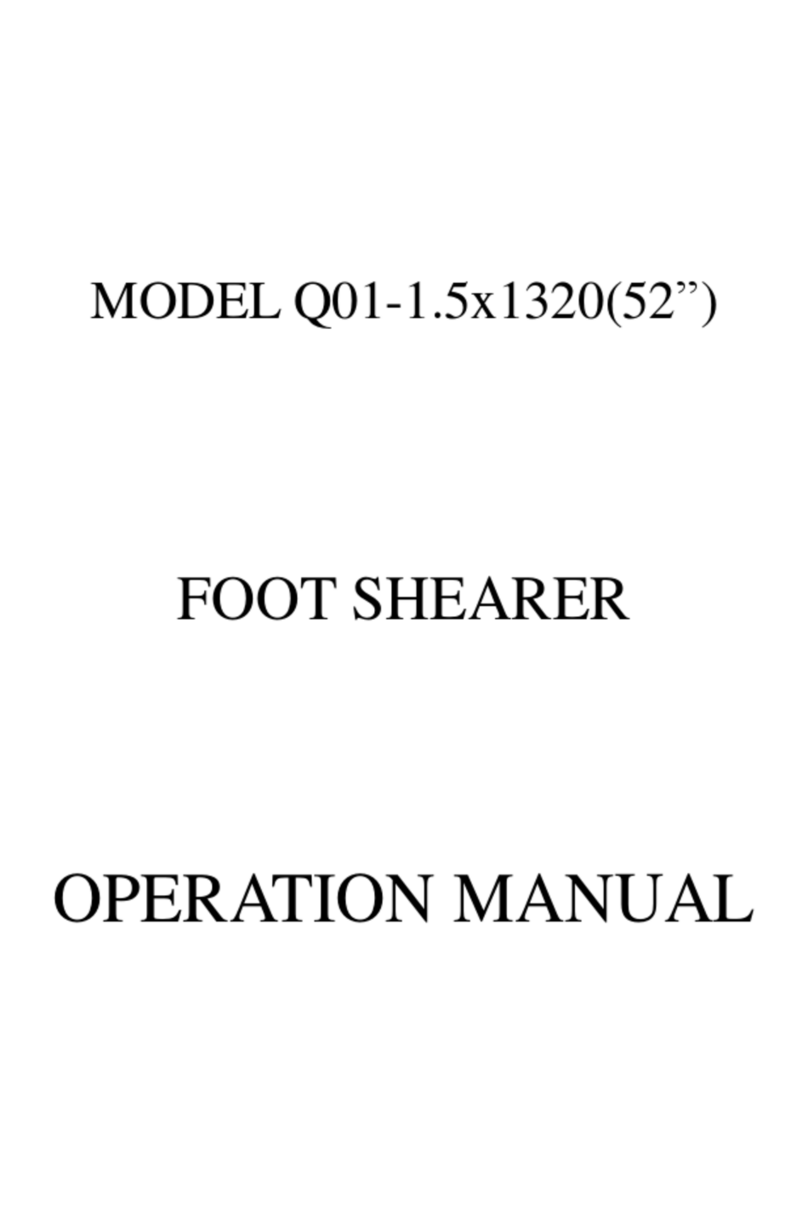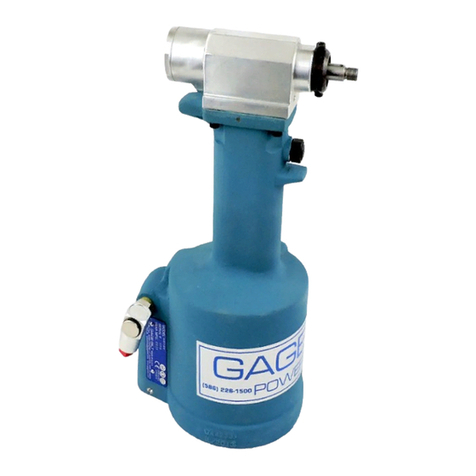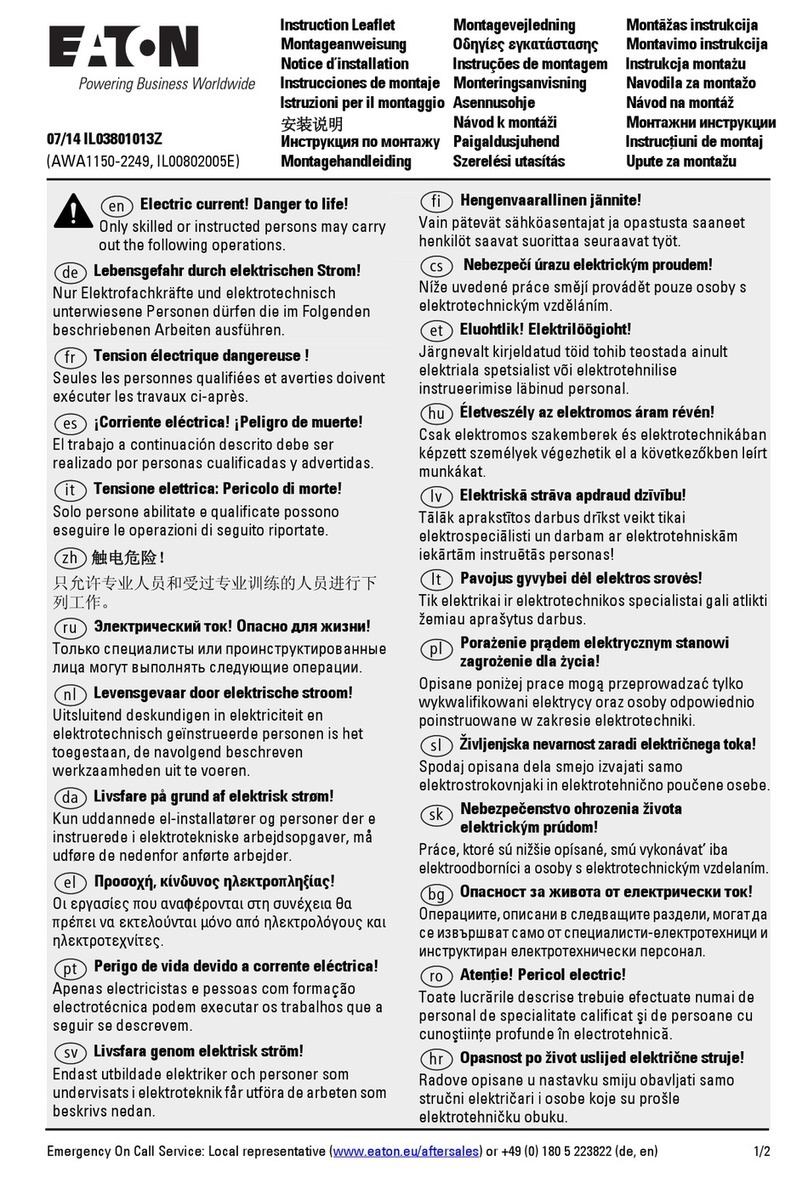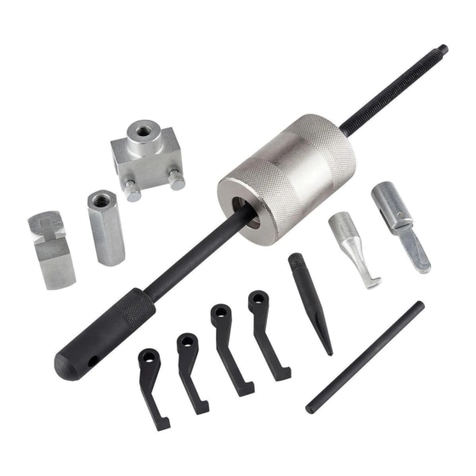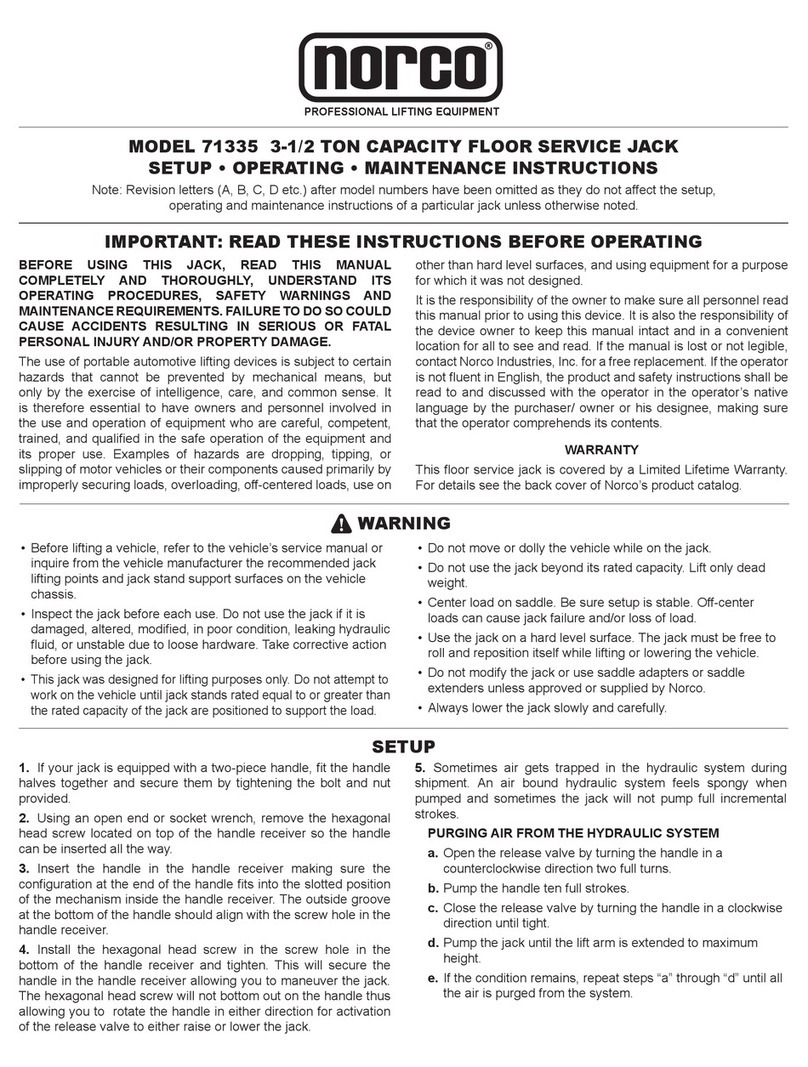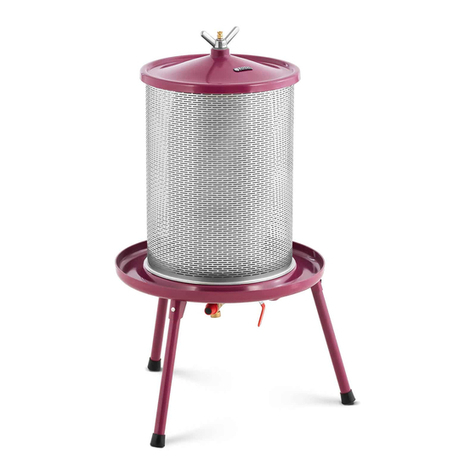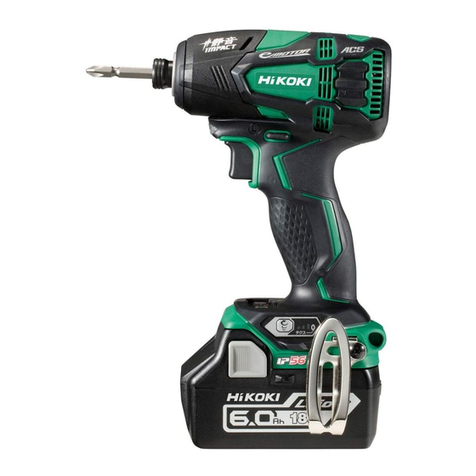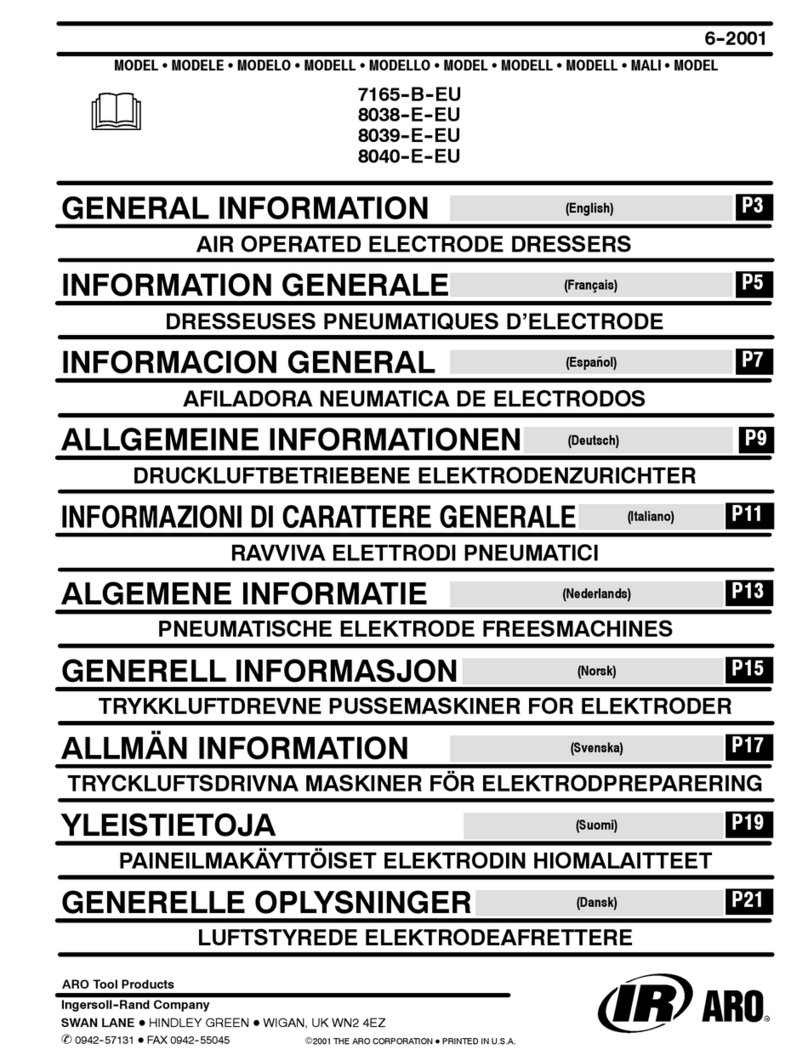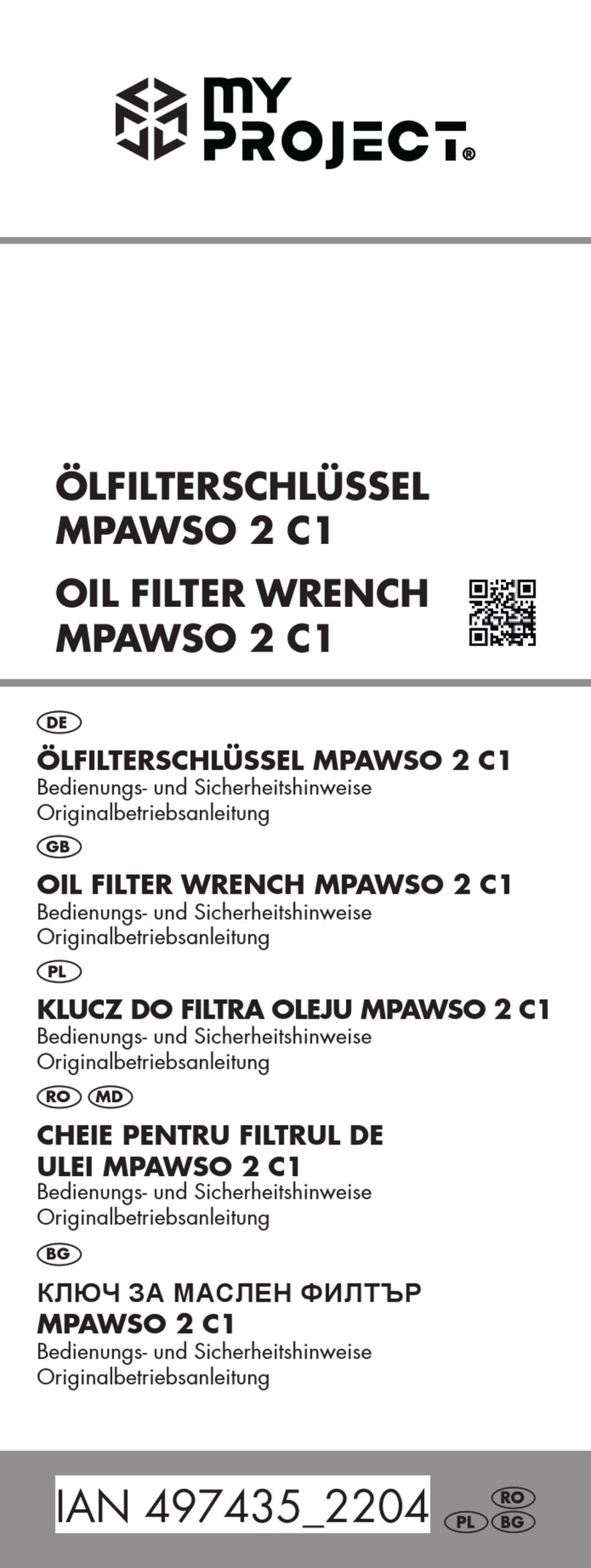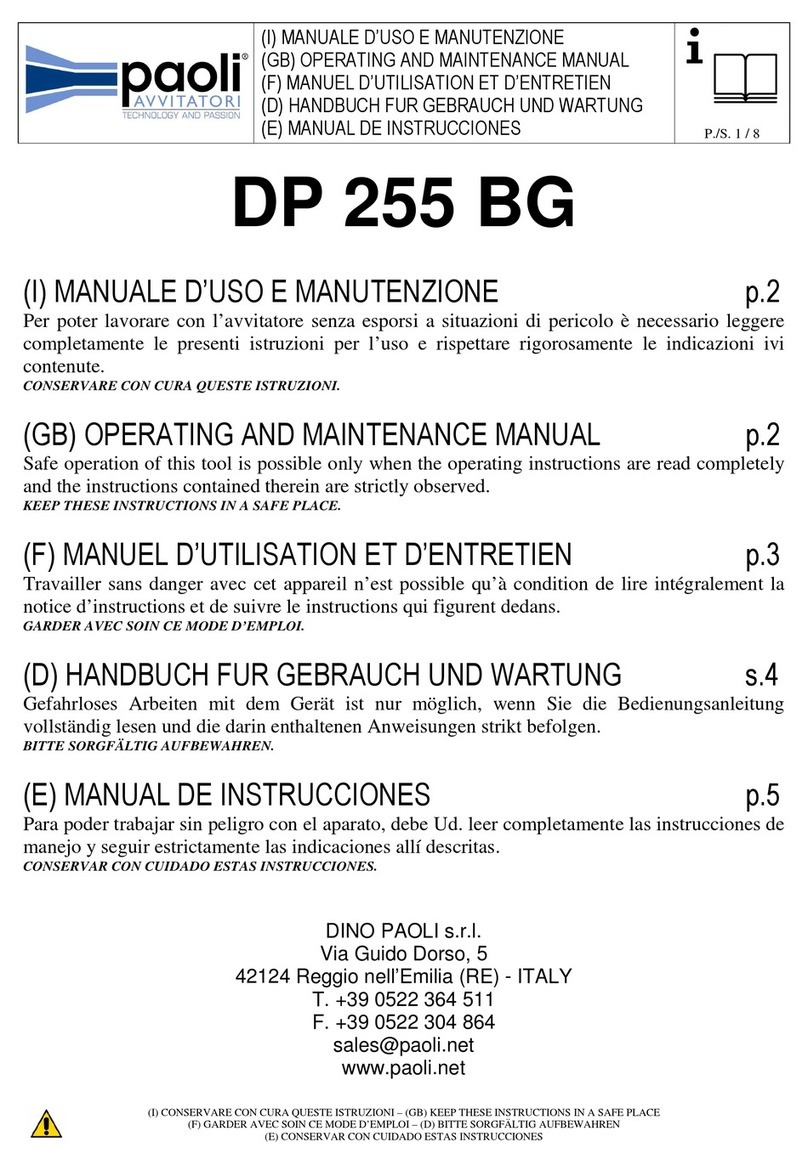Digga Mini Trencher Programming manual

OPERATORS & PARTS MANUAL
TRENCHERS


3
THANK YOU
Congratulations on the purchase of your new DIGGA product! This product was carefully designed and manufactured to give you years of
dependable service. To keep it operating in top working condition please read the instructions in this manual, observe all safety
precautions and maintenance procedures as described in the following pages.
Contact your DIGGA dealer for any further information pertaining to this product or for further information on other products available in the
DIGGA range.
1 To The Purchaser
C
M
Y
CM
MY
CY
CMY
K
Digga DIG-000168.pdf 16/10/2009 1:36:04 PM
ABOUT THIS MANUAL
This manual has been designed to help you do a better, safer job. Read
this manual carefully and become familiar with its contents.
Remember; never let anyone operate this unit without reading the “Safety
Precautions” and “Operating Instructions” sections of this manual.
Unless noted otherwise, right and left sides are determined from the
position of the operator when behind the product facing forward.
MODEL______________________________________
SERIAL NUMBER______________________________
DATE PURCHASED____________________________
The parts department needs this information
to insure accurate parts can be sent to the
authorised service agent.
Your Digga Trencher is a user non serviceable part. Unauthorised disassembly will void warranty. All service and warranty must be
performed by an authorised DIGGA service agent. To facilitate warranty or service, record the model and serial number of your unit in the
space provided on this page. This information may be obtained from the identication plate located on the product.
IMPO R TA NT: WHEN SE RVICI N G O R AS S E M BLI N G YOUR P RO D UCT, R E M E M BER TO USE O N LY G E N UINE
DIGG A R EPL ACEM E NT PA RTS. S UBST I TUT E PA R TS MAY N OT MEET T H E STA N DA R D S R EQ U I R E D FO R SAFE ,
DEP ENDABLE O PER AT I O N. US E O F NON GEN U I N E DIGG A PA R TS WILL VOID WARR A N T Y A N D D I GGA W I L L
ACCEPT NO LIABILITY WHAT SO EVER FOR CONSEQUENTIAL OR SPECIAL DAMAGES.

4PM-000005 - Trencher Operators Manual - December 2012
2 Table of conTenTs
1 TO THE PURCHASER....................................................................... 3
2 TABLE OF CONTENTS...................................................................... 4
3 PREPARATION FOR USE................................................................. 5
4 INSTALLATION AND OPERATING INSTRUCTIONS........................ 6
5 MAINTENANCE ................................................................................ 10
6 SAFETY STICKERS.......................................................................... 18
7 SPARE PARTS................................................................................... 19
8 TROUBLESHOOTING....................................................................... 20
9 SAFETY PRECAUTIONS................................................................... 21
10 WARRANTY........................................................................................ 25
MODELS COVERED IN THIS MANUAL
MINI TRENCHER BIGFOOT BIGFOOT XD HYDRIVE HYDRIVE XD

5
3 PreParaTion for use
To avoid any inconvenience before operation, please check that you have received the following items which you may have ordered
REF DIGGA TRENCHERS QTY
ATRENCHER - COMPLETE WITH DIGGING BOOM,
DANGER BAR 1
B AUGER FLIGHT/S 1 / 2
C DIGGING CHAIN OF YOUR CHOICE 1
DFRAME 1
E CRUMBER BAR
F HYDRAULIC HOSE KIT Set
G QUICK RELEASE COUPLERS Set
a
f
c
D
e
G
b

6PM-000005 - Trencher Operators Manual - December 2012
1. Remove the shipping banding from around the Trencher and Frame/Hitch.
2. Remove any attachments from the front of the Parent Machine.
3. Check that all nuts and bolts are tightened on the frame or hitch and that the frame/hitch is correctly mounted on the trencher.
4. Following all standard safety practices and the instructions for installing an attachment in your machine operator’s manual, install
the Trencher onto your machine.
5. Once the trencher is connected via the frame/hitch Lower the unit to the ground and remove the key from the parent machine.
6. Relieve any pressure from the auxiliary hydraulic system and after making sure that there is not any foreign matter
on the hydraulic ouplers, connect the power and return couplers to the auxiliary hydraulic system of your machine.
7. Connect the case drain coupler to the case drain on your machine. Case Drain must be connected or damage to motor will result
4 insTallaTion anD oPeraTinG insTrucTions
Digga Trenchers are designed for cutting narrow, straight trenches in the soil prior to laying electrical, telephone and cable lines, or water
and gas pipe. The DIGGA Trencher attaches to the tool bar/quick-attach mechanism of your Machine. Due to this arrangement, thorough
knowledge of the machinery controls is necessary for machine operation. Read and understand your machine operator’s manual for
information regarding machine operation before attempting to use the Trencher. When a Digga Trencher is purchased from Digga or a
DIGGA Dealer/Distributor the frame/attachment is matched for suitability and compatibility to the ow, pressures & load ratings of the original
machine it was purchased for. For tment of the Digga Trencher to other machines you must rst contact your DIGGA dealer and receive written
conrmation to ensure you do not incorrectly t the Cleana Angle Broom to a machine with higher, pressure or rated load capacities than
what the Digga Trencher was designed for. Warranty will be void if the Digga Trencher is tted to an alternative machine without rst
receiving written conrmation from your DIGGA dealer. Exceeding the recommended max ow, pressure, or rated load capacity of the
Digga Trencher as stated on the serial tag will void all warranty.
Check the work site and identify the extent of the work to be carried out and note any possible hazards or constraints, Underground
cables, services etc. DIAL 1100 Before you dig. Review the job at hand and determine the chain type is appropriate for the intended
digging conditions. Ie. Do not use cup teeth in medium to hard conditions, Diggatac is the correct selection.
The Trencher is not a chainsaw and must not be used above ground for cutting, shearing or any other use but what the Trencher has been
designed for.
NOTE: IT IS IMPORTANT TO MAKE SURE THE LOCKING MECHANISM ON YOUR QUICK ATTACH IS
ENGAGED, THEREFORE LOCKING THE ATTACHMENT ONTO THE MACHINE.
SAFETY FIRST!! READ AND UNDERSTAND THE SAFETY INSTRUCTIONS BEFORE BEGINNING ANY
TRENCHER MOUNTING.

7
4 insTallaTion anD oPeraTinG insTrucTions
DO NOT LOCK THE AUXILIARY HYDRAULICS OF YOUR MACHINE IN THE “ON” POSITION.
FAILURE TO OBEY THIS WARNING COULD RESULT IN DEATH OR SERIOUS INJURY.
SAFETY FIRST!! READ & UNDERSTAND THE SAFETY INSTRUCTIONS BEFORE BEGINNING
ANY TRENCHER OPERATING.
Never lift this product:
● Above the operator’s eye level OR to a height where visibility is obstructed, which ever is lower.
FAILURE TO OBEY THE FOLLOWING PROCEDURES COULD RESULT IN DEATH OR
SERIOUS INJURY.
8. Make sure the couplers are fully connected and locked.
9. Route the hoses in such a fashion as to avoid pinching or chang.
10. Check the Chain teeth are not worn. Ensure all worn parts are replaced. Worn parts will become ineffective and severely diminish the
overall performance of the Trencher.
11. The machine is now ready for use.
TO CUT A TRENCH
1. Before operating the trencher, ensure the Crumber bar is pinned in the locked back position.
2. Raise the Trencher so the trencher is horizontal to the ground, with the trencher at approx 200mm off the ground start the rotation
of the chain. Ensure the chain is rotating freely before engaging full RPM.
3. Take the machine to full RPM. With the machine at full RPM engage the trencher into the ground.
4. It will take approximately 1m of trenching before you can operate at the desired depth. With the Crumber Bar still pinned in the
locked back position slowly crowd the trencher over to the desired depth whilst reversing the parent machine.
5. Once the desired depth has been reached. Raise the trencher, stop chain rotation. Use the pin to lock the Crumber Bar forward in
the trenching position. Lower the trencher and continue.
The Crumber has springs to give constant down pressure on the bottom of the trench in order to scoop all spoil missed in
the initial cut of the chain, throwing it back onto the chain to be carried back to the surface.
WHILE CHAIN IS MOVING ALL BYSTANDERS MUST BE A MINIMUM OF 6M/20FT AWAY. IT IS THE
RESPONSIBILITY OF THE OPERATOR TO ENSURE ALL SAFETY PROCEDURES ARE FOLLOWED

8PM-000005 - Trencher Operators Manual - December 2012
If starting a trench with the Crumber Bar in the trenching position it will take approximately 2m of trenching before you can operate
at the desired depth. Do not apply excessive downward pressure on the Crumber Bar while beginning a trench. This will cause the
spring to over extend as it is going down the rst part of the trench resulting in Crumber failure and damage.
6. The Trencher is designed to operate with the depth adjustable ‘foot’ on the ground. Do not apply excessive pressure to the foot.
Under no circumstances should the front of the machine be lifted off the ground by the Trencher.
● The trencher is designed to cut straight trenches, it cannot be used for cutting trenches around corners. However if desired
a curved trench can be achieved by cutting in a slow wide arc.
● The parent machine is to be reversed when trenching. You cannot trench while driving forward.
● If the trencher stalls while digging, move forward or raise slightly to free the trencher then continue. Do not continually stall the
trencher. Allow the trencher time to cut and clear spoil.
● Never use earth chains when digging in difcult hard ground conditions.
● Always check chain condition and ensure teeth are tightened before use.
● Never continue to dig if the chain begins to jump (due to incorrect style/type of teeth used in harder ground conditions)
CAUTION: DO NOT RAPIDLY ENGAGE FORWARD AND REVERSE OR ON/OFF ROTATIONAL
MOVEMENT TO CLEAR THE TRENCHER. THIS ACTION CAN CAUSE CAVEATATION OF THE
MOTOR AND VOID MOTOR WARRANTY.
4 insTallaTion anD oPeraTinG insTrucTions
REMOVAL AND STORAGE
1. Set the attachment on the ground and follow the standard shut down procedure in your loader operators manual.
2. With the loader OFF, disengage the attachment lock pins, release hydraulic pressure from the auxiliary hydraulic system and
disconnect the hydraulic couplers from the loader.
3. Start the machines engine and make sure that the lift arm is lowered and in contact with the loader frame.
4. Roll the attachment mechanism forward and slowly back up until the attachment is free from the machine.
5. Remove and store the attachment in a dry and protected place. Leaving the Digga Trencher outside will materially shorten its life.
WHEN ATTACHMENTS NOT ON PARENT MACHINE:
It is a requirement of the Australian Work place Health and Safety act 1995 that safe systems of work are employed when handling
any attachments. Complete compliance with Work place Health and Safety issues is compulsory and all due care and attention must
be observed at all times in any method of moving, transporting or storing any such device when not attached to a parent machine. We
recommend attachments are well secured when being moved or in transit and furthermore prior to moving, storing, loading/unloading or
parking it is suggested that the attachment is strapped/secured to a pallet or enclosed in a suitable container to minimise any movement or
loss of the load during such activity. NO responsibility for loss or damage to persons or property in any regard can be attributed to Digga.

9
MINI/BIGFOOT/BIGFOOT XD
To adjust the Trench depth on your trencher, you will need to loosen and remove the two 5/8” unc nuts and
spring washers that hold the skid plate onto the trencher side plate. Then remove the skid plate and rotate it
until the two xed bolts line up with the holes for the Trench Depth that you require. See above illustration and
take note of nut positions to suit 600mm, 750mm, 950mm and 1200mm Trench Depths (for the 1200 Dig Bigfoot
XD, other trenchers will have different depths). Then reassemble the skid plate onto the side plate, check that
the star washers are still in good condition and tighten the nuts back up rmly using hand tools.
HYDRIVE/HYDRIVE XD
To adjust the trench depth on your trencher adjust the cutting angle until at the required depth.
600mm
750mm
900mm
1200mm
GrounD level
4 insTallaTion anD oPeraTinG insTrucTions
TRANSPORTING THE ATTACHMENT
1. Follow all federal, state and local regulations when transporting the unit on public roads.
2. Use extra care when loading or unloading the machine onto a trailer or truck. Disconnect hydraulic couplers during transportation.

10 PM-000005 - Trencher Operators Manual - December 2012
5 mainTenance
● Make sure that all nuts and bolts are in place and properly tightened.
● Make sure that all other fasteners are in place and are performing their specied function.
● Make sure that all hydraulic ttings are tightened and that there are no leaks in any ttings or hoses.
● Make sure that all safety signs are in place, are clean, and are legible. (SEE THE SAFETY SIGN SECTION)
● Check for any Oil leaks.
● Wear and tear on Pins, linkages, clips, chain or chain teeth.
● Replace any damaged parts and excessively worn parts.
● Use only manufacturer recommended replacement parts. Other parts may be substandard in t and quality.
● Always wear safety goggles or glasses when inspecting equipment.
SAFETY FIRST!! READ AND UNDERSTAND THE SAFETY INSTRUCTIONS BEFORE BEGINNING ANY
TRENCHER MAINTENANCE.
BEFORE FIRST USE
BEFORE EACH USE
● Inspect the attachment for shipping damage. If damage does exist, do not operate until the damaged parts have been replaced
or repaired.
● Check the Hydraulic Oil level of the motor.
EVERY 10 HOURS OF USE
Always wear safety goggles or glasses when inspecting equipment
Escaping uid under pressure can have
sufcient force to penetrate the skin causing
serious personal injury. Fluid escaping from a
very small hole can be almost invisible. Use a
piece of cardboard or wood, rather than hands
to search for suspected leaks. Keep unprotected
body parts, such as face, eyes, and arms as far
away as possible from a suspected leak. Flesh
injected with hydraulic uid may develop
gangrene or other permanent disabilities.
If injured by injected fluid, see a doctor at
once. If your doctor is not familiar with this
type of injury, ask him to research it
immediately to determine proper treatment.
WARNING!
CARDBOARD
HYDRAULIC HOSE
OR FITTING
MAGNIFYING GLASS

11
5 mainTenance
ALWAYS ENSURE THAT THE HYDRAULIC MOTOR IS PRIMED WITH HYDRAULIC FLUID PRIOR TO USE FOLLOWING
ANY REPAIRS TO THE TRENCHER, OR THE PARENT MACHINE IF A LEAK IS DETECTED WHILE CONNECTED TO
THE TRENCHER. DO NOT ALLOW THE TRENCHER TO RUN WITHOUT OIL AT ANY TIME.
NOSE ROLLER BEARING REPLACEMENT
1. To replace the nose roller bearing,
rstly remove circlip using a pair of
straight circlip pliers Fig 1.
2. Use a press to push the
bearing out ensuring the pipe
underneath is larger than the
bearing Fig 2.
Fig 1 Fig 2 Fig 3
SCRAPER SHOE REPLACEMENT
SCRAPER SHOE (PLASTIC)
The Scraper shoe is designed to be able to ip end for end when worn. This gives the operator an
extended use before replacing. To either ip or replace the shoe remove the 3 bolts. With a new shoe,
it may be at when purchased. To mould this into an arc form simply place shoe between the jaws of a
vice and over bend , replace bolts – bottom rst.
HEAVY DUTY SCRAPER SHOE (METAL)
The Heavy Duty scraper shoe is designed to be used with the Hydrive XD and the Bigfoot XD.
3. When pressing the new bearing in ensure the drift used is
the correct size. ie; The drift must sit against the outside shell of
the bearing being careful not to damage the ring that holds the
bearing together, make sure the bearing is sitting against the lip on
the opposite side of the nose roller and replace circlip.
NOTE: A HAMMER IS NOT RECOMMENDED FOR THIS PROCEDURE AS IT CAN DAMAGE THE
NEW BEARING.

12 PM-000005 - Trencher Operators Manual - December 2012
SPROCKET REPLACEMENT
Firstly remove ½” bolt holding the auger, then remove auger.
Using a 3/16” Allen key loosen the 2 grub screws in the
retaining collar and slide collar off the shaft. (shown in Fig 1).
Slide the sprocket off the shaft and replace with new sprocket. It is
recommended Anti-seize be applied to shaft before replacement of
sprocket (Shown in Fig 2)
Fig 1 Fig 2
5 mainTenance
BOOM ADJUSTMENT
iMPORTANT: ShuT dOwN TReNcheR & MAchiNe beFORe ANy AdjuSTMeNTS ARe MAde
1. Use spanner supplied to
wind adjuster nut clockwise
for loosening, anti-clockwise
for tightening
a
b
suPPly from machine
1. The Trencher chain must rotate
in an anti-clockwise direction (when
viewed from the Motor side of the
Trencher). The Supply Line from the
Parent machine must be connected
to the ‘A’ port on the Trencher Motor
HYDRAULIC HOSE CONNECTION
NOTE: IF THE SPROCKET CANNOT BE REMOVED BY TAPPING WITH A HAMMER THEN A PULLER MAY
HAVE TO BE USED.

13
AUGER ADJUSTMENT
1. The spoil removal Auger is double
ended . When a 150mm or 200mm
chain is being used. The Augers must
be on the correct way around. This
illustration shows the Augers being
tted with the narrow end closest to
the chain.
IMPORTANT
When a 250mm or 300mm chain is
being used it is important that the
Augers are turned end for end and
tted with the wide end closest to the
chain. If this is not done the chain
may foul with the Augers.
5 mainTenance
SEAL REPLACEMENT
Before the seal can be replaced remove
retaining collar and sprocket as shown in
sprocket replacement. Then remove the
key and seal protector. Place a screwdriver
between outside of seal and inside of
housing. Tap gently with a hammer until
the seal can be levered out Fig 1. Inspect
the inside of the housing for damage and
if damaged or burred, clean up with emery
cloth.
Proceed to t the seal by using a large punch
and gently tap the seal into place ensuring
the seal is punched in evenly (see Fig 3). This
is very important as any misalignment could
cause damage to the seal and promote a leak.
The seal must be ush with the end of the
housing. Replace seal protector, key, sprocket
and retaining collar. Rell the planetary with
gear oil (See lubrication for correct amount,
grade of gear oil, and oil lling procedures).
Before the seal can be replaced run
some grease around the inside lip of the
seal for lubrication to the shaft. Ensure
there are no burrs on the shaft between
the end of the shaft and the end of the
housing. File if necessary. Using loctite
243 (or equivalent) run a small bead
around the outside of the seal see
Fig 2.
Fig 2 Fig 3Fig 1
NOTE: MAKE SURE ALL GEAR OIL IS DRAINED AT THIS POINT.

14 PM-000005 - Trencher Operators Manual - December 2012
CHAIN ADJUSTMENT
1. To either adjust
chain or remove chain
– remove the ½" Bolt
holding spanner to
outer boom.
2. Use spanner supplied to
wind adjuster nut clockwise
for loosening, anti
clockwise for tightening.
3. To achieve the cor-
rect chain tension: Adjust
the tension on the lower
chain section at the mid-
way point between the
sprockets to allow 15mm
of vertical movement.
Chain
midway point
between sprockets
15m m
5 mainTenance
SCRAPER ADJUSTMENT
1. The adjustment of the scraper/chain
gap via the inner danger bar is done by
removing the bolt with two ¾" spanners
at the end of the outer danger bar. The
inner danger bar is moved out and the
bolt relocated in the second or third hole.
2. The three holes in the inner
boom to allow for Scraper
adjustment. The hole indicated is
the setting from the factory.
3. Use these holes to adjust the
scraper distance when the gap
becomes less than 100mm.
4. The gap between the chain
teeth and scraper plate should
be at least 100mm to prevent
any binding.
100m m

15
5 mainTenance
PLANETARY GEAR OIL
The Trencher Planetary Unit is a sealed Unit. If there is any sign of oil leaks please contact your nearest DIGGA dealer before carrying out
any repairs, as there can be other causes for seal leaks.
The Planetary Drive Unit in the Trencher uses the Gear Oil (Valvoline EPG320) for lubrication of gears and bearings. The unit holds 600ml
of gear oil. The gear Oil should be drained and replaced after the rst eight (8) months of use from purchase. Thereafter every twelve
(12) months or 1000 hours – which ever comes rst. Contact your nearest DIGGA Dealer for Gear Oil change procedure.
● Continuous operating temperature must not exceed 80°c.
● During extended stationary periods (one month or more), the unit should be run monthly to immerse all internals in oil, thereby
preventing corrosion.
● Oil should be changed when hot, to prevent a build up of sludge deposits. Flush interior of unit with uid recommended by oil
companies.
● Check for leaks regularly and if an oil leak is detected contact your nearest DIGGA Dealer for remedy instructions.
● Use only the prescribed oil when relling. Valvoline EPG320 Gear Oil.
● DO NOT mix oil of different viscosity, NOT even those of the same brand.
● NEVER mix mineral and synthetic oils.
● Cleanliness is necessary when changing oil.

16 PM-000005 - Trencher Operators Manual - December 2012
FITTING A TRENCHER CHAIN - MINI TRENCHER / BIGFOOT / BIGFOOT XD
5 mainTenance
1. Start with the Trencher securely attached to a lifting device or
machine, ensure the adjustable boom is fully retracted.
2. Place Trencher on the ground, position chain in front of the
nose roller with cutting edge of the tooth facing away from the
Trencher. (Figure 1)
3. Lift chain onto Nose Roller (Figure 2) - A suitable lifting device
may need to be used for the larger heavier chains
4. Slide the chain along the boom and over the drive sprocket.
(Figure 3)
5. Raise the Trencher - Ensuring the Trencher is supported and
cannot fall whilst raised from the ground - Bring both ends of
the chain under the boom. (Figure 4)
6. Bring both ends of the chain together and insert the joining pin.
The joining pin must be inserted from the correct side which is
identied by looking at the head of the other link pins and
matching it to the same side. (Figure 5)
7. Tap the joining pin fully home using a soft head mallet. (Figure 6)
8. Insert the keeper pin and bend to secure. (Figure 7)
9. Adjust the chain tension and replace spanner to side of boom.
(Figure 8)
CAUTION: ALL WORK SAFE PRACTICES AND PROCEDURES MUST BE ADHERED TO AND APPROPRIATE
PPE MUST BE WORN.
FIGURE 1 FIGURE 5
FIGURE 5
FIGURE 2 FIGURE 6
FIGURE 3
FIGURE 8
FIGURE 7

17
FITTING A TRENCHER CHAIN - HYDRIVE / HYDRIVE XD
5 mainTenance
1. Start with the Trencher securely attached to a lifting device or
machine, ensure the adjustable boom is fully retracted.
2. Place Trencher on the ground, position chain in front of the
nose roller with cutting edge of the tooth facing away from the
Trencher. (Figure 1)
3. Lift chain onto Nose Roller (Figure 2) - A suitable lifting device
may need to be used for the larger heavier chains
4. Slide the chain along the boom and over the drive sprocket and
down past the idle sprocket. (Figure 3)
5. Raise the Trencher - Ensuring the Trencher is supported and
cannot fall whilst raised from the ground - Bring both ends of
the chain under the boom. (Figure 4)
6. Bring both ends of the chain together and insert the joining pin
The joining pin must be inserted from the correct side which is
identied by looking at the head of the other link pins and
matching it to the same side. (Figure 5)
7. Tap the joining pin fully home using a soft head mallet. (Figure 6)
8. Insert the keeper pin and bend to secure. (Figure 7)
9. Adjust the chain tension and replace spanner to side of boom.
(Figure 8)
CAUTION: ALL WORK SAFE PRACTICES AND PROCEDURES MUST BE ADHERED TO AND APPROPRIATE
PPE MUST BE WORN.
FIGURE 1
FIGURE 2
FIGURE 3
FIGURE 4
FIGURE 5
FIGURE 6
FIGURE 8
FIGURE 7

18 PM-000005 - Trencher Operators Manual - December 2012
6 safeTy - sTicKer locaTion
PLACEMENT OR REPLACEMENT OF SAFETY
SIGNS
1. Clean the area of application with non-ammable
solvent, then wash the same area with soap and
water.
2. Allow the surface to fully dry.
3. Remove the backing from the safety sign, exposing
the adhesive surface.
4. Apply the safety sign to the position shown in the
diagram above and smooth out any bubbles.
INSTRUCTIONS
● Keep all safety signs clean and legible.
● Replace all missing, illegible, or damaged
safety signs.
● Replacement parts for parts with safety signs
attached must also have safety signs attached.
● Safety signs are available from your dealer for
from Digga Australia.
ITEM 2
CAUTIONKEEP 6M/20FT CLEAR
OF ALL MOVING PARTS
ITEM 3
NO
STEP
♦PLEASE READ OPERATORS MANUAL
BEFORE OPERATION
♦ENTANGLEMENT WITH ROTATING
PARTS CAN CAUSE INJURY OR DEATH
♦ENSURE ALL ONLOOKERS KEEP
6M/20FT CLEAR OF ALL MOVING PARTS
ITEM 4
ITEM NO ORDER CODE DESCRIPTION QTY
1DE-000039 CAUTION - PLEASE READ 1
2DE-000034 CAUTION - 6M/20FT CLEAR 1
3DE-000054 DECAL - NO STEP 1
4DE-000167 CAUTION - TRENCH STRAIGHT 1
5DE-000168 DIGGA SERIAL TAG
1
2
3
4
5

7 sPare ParTs
For further information on spare parts please contact your nearest Digga Service Centre.
www.diggaservice.com
QLD
Head Office - Brisbane
4 Octal St, Yatala QLD 4207
Phone: (07) 5546 6399
Fax: (07) 5546 7922
NSW
Sydney
1 Gallipoli St, Smeaton Grange NSW 2567
Phone: (02) 4647 1400
Fax: (02) 4647 1433
VIC
Melbourne
21-25 Villas Rd, Dandenong VIC 3175
Phone: (03) 9706 6171
Fax: (03) 9706 6164

20 PM-000005 - Trencher Operators Manual - December 2012
8 TroubleshooTinG
CHAIN
TROUBLE POSSIBLE CAUSE REMEDY
Chain does not turn Quick Coupler not completely engaged Check and complete engagement
Quick Coupler failure Replace faulty coupler
An obstruction in one of the hose Remove obstruction
Hydraulic Motor failure Repair or replace. Contact DIGGA dealer
Chain drive failure Check & repair. Contact DIGGA dealer
Nose roller bearing failed Replace bearing
Digging chain too tight Loosen chain tension
Sand or spoil material build up in tooth root of sprocket Raise out of ditch, reverse chain & run to clear build up OR Loosen chain tension
DIGGING
TROUBLE POSSIBLE CAUSE REMEDY
Does not dig fast enough Worn Teeth Replace teeth if necessary
Relief valve set below specications Test and reset if necessary
Quick coupler or Hose restriction Inspect and repair as needed
Hydraulic system too hot Shut down and cool
Cutting a ditch size beyond the machine capabilities REMEMBER: Your Trencher only has the horsepower transmitted through the Hydraulic
Hoses, NOT the full horsepower of the engine
Auger/s running on the ground Raise Trencher - Keep Auger/s off ground
Chain too tight Adjust to Proper Tension
BOOM, DANGER BAR, FOLDBACK CRUMBER BAR
TROUBLE POSSIBLE CAUSE REMEDY
Trenching Boom bent Abuse Replace
Danger Bar bent Abuse Replace
Fold back CRUMBER
BAR bent Abuse Replace
HYDRAULIC OIL
TROUBLE POSSIBLE CAUSE REMEDY
Hydraulic oil overheating Relief valve set too low on Parent Machine. Test & set as needed.
Restriction in Quick Release Coupler or hose. Inspect and repair as needed
Hydraulic Motor or hoses not size balanced to
Parent Machine
Check ows and recommendations and change if necessary. (see DIGGA Dealer)
Parent Machine not equipped with oil cooler or sufcient
sump capacity
Stop and allow to cool naturally when it gets hot.
This manual suits for next models
4
Table of contents
